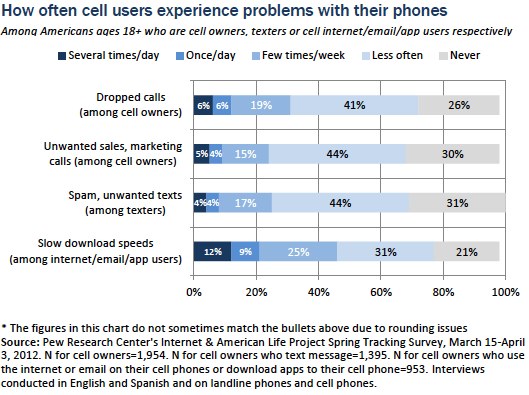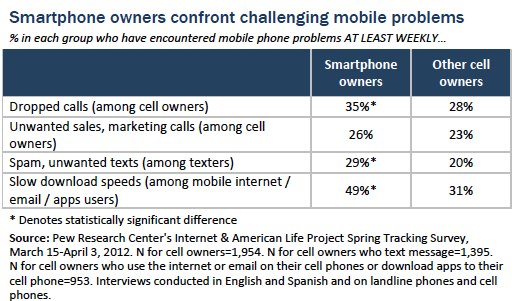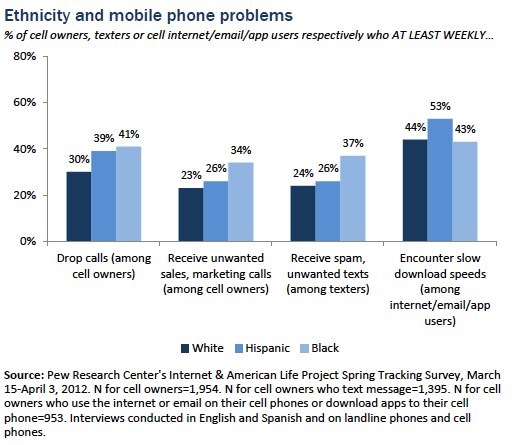Mobile Phone Problems
Even though mobile technology often simplifies the completion of everyday tasks, cell phone owners can also encounter technical glitches and unwanted intrusions on their phones. In an April 2012 survey, the Pew Research Center’s Internet & American Life Project assessed the prevalence of four problems that cell owners might face.
Some 88% of American adults have cell phones, according to this survey, and, of those cell owners:
- 72% of cell owners experience dropped calls at least occasionally. Some 32% of cell owners say they encounter this problem at least a few times a week or more frequently than that.
- 68% of cell owners receive unwanted sales or marketing calls at one time or another. And 25% of cell owners encounter this problem at least a few times a week or more frequently.
Some 79% of cell phone owners say they use text messaging on their cells. We asked them if they got spam or unwanted texts:
- 69% of those who are texters say they get unwanted spam or text messages. Of those texters, 25% face problems with spam/unwanted texts at least weekly.
Some 55% of cell phone owners say they use their phones to go online— to browse the internet, exchange emails, or download apps. We asked them if they experience slow download speeds that prevent things from loading as quickly as they would like:
- 77% of cell internet users say they experience slow download speeds that prevent things from loading as quickly as they would like. Of those cell internet users, 46% face slow download speeds weekly or more frequently.

Our questions were not intended to measure the incidence of illegal marketing to cell phones. They focused on unwanted intrusions. Still, the telemarketing and spam text findings are noteworthy because legal restrictions apply to both activities under certain circumstances. It is against the law in the U.S. to place unsolicited commercial calls to a mobile phone when the call is made by using an automated random-digit dialing generator or if the caller uses a pre-recorded message.1
In the case of unsolicited texts, commercial parties cannot send spam to cell owners who have placed their mobile device on the National Do Not Call registry. For those who have not chosen to go on that registry, governmental regulations bar text messages sent from internet domain names. Any mobile-to-mobile spam messages are permissible to reach consumers on their cell phones, so long as the text contacts were not generated through an automatic dialing system.2
Smartphone owners report more problems
Smartphone owners reported higher incidence levels of these problems, compared with other cell owners, as shown in the table below.

Non-white cell owners confront all four problems at somewhat higher weekly rates than do their white counterparts. This might be tied to the fact that African-Americans and Hispanics are more likely than whites to rely on their cell phones as their primary or exclusive phones for calling and for internet access.3
For instance, more than half of Hispanic cell internet users (53%) face slow download times at least weekly or more often, compared with 44% of white cell internet users who report this problem. Some 41% of black and 39% of Hispanic cell owners reported dropping calls at least weekly, compared with 30% of white cell owners.



